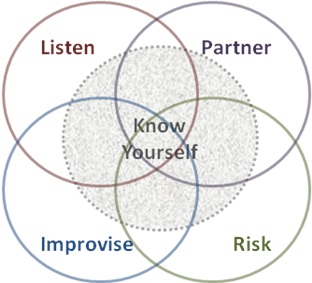It’s ‘Real Simple’: Five Ways to Make a Good First Impression
 Nestled between the delicious food shots and cool clothes in the April print issue of Real Simple magazine is a gem of an article called “Life Lessons: 5 Ways to Make a Good Impression.” Forget firm handshakes and eye contact, shined shoes and prep for the meeting. Real Simple asked five experts to chime in, and I was struck by the ties to the good old Trust Equation.
Nestled between the delicious food shots and cool clothes in the April print issue of Real Simple magazine is a gem of an article called “Life Lessons: 5 Ways to Make a Good Impression.” Forget firm handshakes and eye contact, shined shoes and prep for the meeting. Real Simple asked five experts to chime in, and I was struck by the ties to the good old Trust Equation.
Five ways to make a good first impression
Here’s the speed version from Real Simple:
- Stop Talking. Listen. From Ann Demarais PhD – executive coach and coauthor of “First Impressions”
- Show Your Flaws. Be Vulnerable. From Lucila McElroy, founder of WeAreMomentum.com
- Use Names. Repeat. From Dr. Julie Albright, University of Southern California, LA
- Just be Humble. Don’t Take all the Credit or Pass off All the Blame. From Ben Dattner, author of “The Blame Game”
- Look Interested. Be Interested. From Joe Navarro, former FBI special agent and author of “What Every Body is Saying”
The Two Hardest Things
For most people the two hardest strengths to master from the Trust Equation are increasing Intimacy (empathy, discretion, vulnerability) and lowering Self-orientation (where is the focus, on you or the other person?)
This handy little checklist gives ideas on both.
Stop talking and listen – sounds a lot like Other-orientation, lowering Self-orientation and really focusing on what someone else is saying. Likewise, using and repeating names.
When this “trick” is elevated from trick status to real concern, you have both Intimacy and Other-orientation. And Joe Navarro paraphrases the kids’ adage “act enthusiastic and you’ll feel enthusiastic” for grown-ups. Again, genuine interest.
Tips two and four land squarely in the realm of Intimacy. Julie McElroy describes a meeting with a woman who intimidated her; McElroy let down her guard, let herself be vulnerable, and had an “amazing” conversation because the other woman was able to do the same.
And Ben Dattner says it all with “just be humble.” He cautions against dressing up your strengths to look like weaknesses. “I care too much. I work too hard. (Ugh).”
Just for today
Just for today, I’m going to practice these five little skills. Care to join me?

 A competency model won’t answer the mail when it comes to building trustworthiness—in fact,
A competency model won’t answer the mail when it comes to building trustworthiness—in fact,